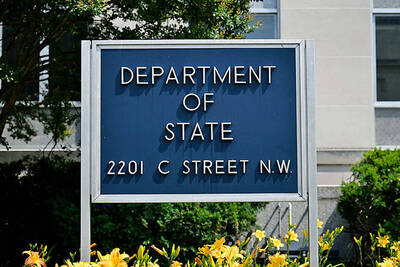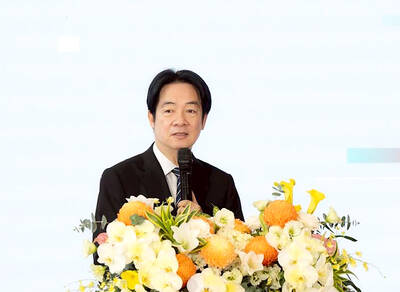China offered to repair damage by protesters to Japan's embassy in Beijing, but kept up pressure in a diplomatic row yesterday, invoking wartime atrocities and saying Japan needed to show sincerity to reverse a downward spiral in relations.
The Chinese Foreign Ministry said a two-day visit to Beijing by Japanese Foreign Minister Nobutaka Machimura to patch things up had yielded consensus on some issues.
But the two sides remained far apart on broader disputes that have dragged relations to their lowest point in decades.
China has seen three weekends of violent protests against Japan, with many angry about a revised Japanese school textbook they say whitewashes Japan's wartime history. Protesters also oppose Japan's bid for a permanent seat on the UN Security Council.
"There have already been statements," said Chinese Foreign Ministry spokesman Qin Gang (秦鋼). "What's key is action."
The Asian powerhouses appear to be talking past each other, risking a high-stakes partnership worth US$178 billion in annual trade. Still, there have been gestures.
Protesters smashed more than 20 windows at Japan's embassy in Beijing as thousands of demonstrators converged on it on April 9, an embassy spokesman said yesterday, adding that a company under the Chinese Foreign Ministry had offered to do the repair work.
"They offered to fix the damage" to the embassy office building, he said. "My colleagues in Tokyo are thinking of how to respond to this offer."
Protesters also damaged the Japanese ambassador's residence in Beijing and, in a separate protest this weekend, the consulate in Shanghai. Japan was still seeking compensation for the damage.
The Chinese Foreign Ministry and Diplomatic Services Bureau, which manages diplomatic property in China, declined to comment.
In a move unlikely to help matters, Japanese lawmakers said they planned to visit Tokyo's Yasukuni Shrine, a Shinto sanctuary where convicted Japanese war criminals are honored along with the nation's 2.5 million military war dead.
They set their shrine visit for Friday, when Japanese Prime Minister Junichiro Koizumi and Chinese President Hu Jintao (胡錦濤) are expected to meet on the sidelines of a multilateral summit in Jakarta to try to mend ties.
China says repeated trips to the shrine by Japanese leaders including Koizumi are the top irritant to relations.
"We hope Japan's leaders will fully respect the feelings of the victims in Asian countries, including China," Qin said.
Koizumi defended the visits yesterday, saying they do not harm Japan's interests.
"Each country has its own history and there are differences in tradition and ways of thinking," he said.
Keeping Japan's wartime past in the public spotlight, the official Xinhua News Agency said China would seek UNESCO World Heritage protection for the ruins of a Japanese germ warfare center during World War II called Unit 731.
Located in northeastern China, the labs, prisons and crematoria played grim host to experiments on humans to develop germ weapons, like bubonic plague, typhoid, anthrax and cholera.
"We will apply for World Heritage status to let more people in the world know the truth," Wang Peng, curator of the 731 Exhibition Hall, was quoted as saying.
Tokyo neither denies nor recognizes the activities of the unit.
Meanwhile, in a sudden shift, Chinese nationalist Web sites that have encouraged sometimes violent anti-Japanese protests yesterday urged supporters not to target Japanese citizens.
"We oppose the Japanese right-wingers and the politicians that support them, not the Japanese people," said a statement on the Web site 9-18.com, which earlier had publicized details of protests.
"Friendly Japanese people are our friends and brothers in arms," the statement said.
The site's name refers to the date of the Sept. 19, 1931, start of Japan's invasion of China.
The Web sites' statements appeared aimed at preventing violence at upcoming protests, several of which are scheduled for early next month. They also echoed government appeals for calm.
Another Web site, the Aiguozhe Patriotic Alliance Net, said violence would hurt the nationalist cause.
While mostly peaceful, protests have led to some "inharmonious, even unhappy events," the statement said. "This is a long battle, and we must avoid senseless, rash acts."
Some visitors to the sites rejected appeals for calm.
"What we need now is blood, not logic," said one unsigned posting on the Aiguozhe site.
In Japan, there have been signs that a backlash may be building. Police cited 25 cases of harassment against Chinese interests since the protests in China began, including minor damage to the ambassador's residence and a Chinese-language school in Tokyo.
UN Secretary-General Kofi Annan also weighed in on Monday in New York, encouraging Chinese and Japanese leaders to use their attendance at a Jakarta summit tomorrow to try to resolve their differences peacefully.

MISINFORMATION: The generated content tends to adopt China’s official stance, such as ‘Taiwan is currently governed by the Chinese central government,’ the NSB said Five China-developed artificial intelligence (AI) language models exhibit cybersecurity risks and content biases, an inspection conducted by the National Security Bureau (NSB) showed. The five AI tools are: DeepSeek, Doubao (豆包), Yiyan (文心一言), Tongyi (通義千問) and Yuanbao (騰訊元寶), the bureau said, advising people to remain vigilant to protect personal data privacy and corporate business secrets. The NSB said it, in accordance with the National Intelligence Services Act (國家情報工作法), has reviewed international cybersecurity reports and intelligence, and coordinated with the Ministry of Justice Investigation Bureau and the National Police Agency’s Criminal Investigation Bureau to conduct an inspection of China-made AI language

LIMITS: While China increases military pressure on Taiwan and expands its use of cognitive warfare, it is unwilling to target tech supply chains, the report said US and Taiwan military officials have warned that the Chinese People’s Liberation Army (PLA) could implement a blockade within “a matter of hours” and need only “minimal conversion time” prior to an attack on Taiwan, a report released on Tuesday by the US Senate’s China Economic and Security Review Commission said. “While there is no indication that China is planning an imminent attack, the United States and its allies and partners can no longer assume that a Taiwan contingency is a distant possibility for which they would have ample time to prepare,” it said. The commission made the comments in its annual

CHECKING BOUNDARIES: China wants to disrupt solidarity among democracies and test their red lines, but it is instead pushing nations to become more united, an expert said The US Department of State on Friday expressed deep concern over a Chinese public security agency’s investigation into Legislator Puma Shen (沈伯洋) for “secession.” “China’s actions threaten free speech and erode norms that have underpinned the cross-strait ‘status quo’ for decades,” a US Department of State spokesperson said. The Chongqing Municipal Public Security Bureau late last month listed Shen as “wanted” and launched an investigation into alleged “secession-related” criminal activities, including his founding of the Kuma Academy, a civil defense organization that prepares people for an invasion by China. The spokesperson said that the US was “deeply concerned” about the bureau investigating Shen

‘TROUBLEMAKER’: Most countries believe that it is China — rather than Taiwan — that is undermining regional peace and stability with its coercive tactics, the president said China should restrain itself and refrain from being a troublemaker that sabotages peace and stability in the Indo-Pacific region, President William Lai (賴清德) said yesterday. Lai made the remarks after China Coast Guard vessels sailed into disputed waters off the Senkaku Islands — known as the Diaoyutai Islands (釣魚台) in Taiwan — following a remark Japanese Prime Minister Sanae Takaichi made regarding Taiwan. Takaichi during a parliamentary session on Nov. 7 said that a “Taiwan contingency” involving a Chinese naval blockade could qualify as a “survival-threatening situation” for Japan, and trigger Tokyo’s deployment of its military for defense. Asked about the escalating tensions